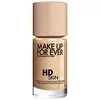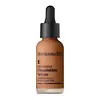Make Up For Ever HD Skin Undetectable Longwear Foundation Versus Perricone MD No Makeup Foundation Serum Broad Spectrum SPF 20
What's inside
What's inside
 Key Ingredients
Key Ingredients

 Benefits
Benefits

 Concerns
Concerns

 Ingredients Side-by-side
Ingredients Side-by-side

Water
Skin ConditioningMethyl Trimethicone
Skin ConditioningAlcohol
AntimicrobialIsododecane
EmollientButylene Glycol
HumectantSynthetic Fluorphlogopite
Cetyl PEG/PPG-10/1 Dimethicone
EmulsifyingPhenyl Trimethicone
Skin ConditioningAcrylates/Dimethicone Copolymer
Skin ConditioningGlycerin
HumectantSilica
AbrasiveDimethicone
EmollientDisteardimonium Hectorite
StabilisingSorbitan Sesquioleate
EmulsifyingDimethicone Crosspolymer
Emulsion StabilisingSodium Myristoyl Glutamate
CleansingSodium Benzoate
MaskingSodium Chloride
MaskingVp/Va Copolymer
Propylene Carbonate
SolventParfum
MaskingSodium Citrate
BufferingHexadecene
SolventAluminum Hydroxide
EmollientHydrogen Dimethicone
Glyceryl Undecyl Dimethicone
Tocopherol
AntioxidantCitric Acid
BufferingPhenethyl Alcohol
MaskingSaccharide Isomerate
HumectantPentaerythrityl Tetra-Di-T-Butyl Hydroxyhydrocinnamate
AntioxidantCI 77891
Cosmetic ColorantCI 77491
Cosmetic ColorantCI 77492
Cosmetic ColorantCI 77499
Cosmetic ColorantWater, Methyl Trimethicone, Alcohol, Isododecane, Butylene Glycol, Synthetic Fluorphlogopite, Cetyl PEG/PPG-10/1 Dimethicone, Phenyl Trimethicone, Acrylates/Dimethicone Copolymer, Glycerin, Silica, Dimethicone, Disteardimonium Hectorite, Sorbitan Sesquioleate, Dimethicone Crosspolymer, Sodium Myristoyl Glutamate, Sodium Benzoate, Sodium Chloride, Vp/Va Copolymer, Propylene Carbonate, Parfum, Sodium Citrate, Hexadecene, Aluminum Hydroxide, Hydrogen Dimethicone, Glyceryl Undecyl Dimethicone, Tocopherol, Citric Acid, Phenethyl Alcohol, Saccharide Isomerate, Pentaerythrityl Tetra-Di-T-Butyl Hydroxyhydrocinnamate, CI 77891, CI 77491, CI 77492, CI 77499
Cyclopentasiloxane
EmollientWater
Skin ConditioningButyloctyl Salicylate
Skin ConditioningTriheptanoin
Skin ConditioningAcrylates Copolymer
Dimethicone
EmollientC13-16 Isoparaffin
SolventAlcohol Denat.
AntimicrobialButylene Glycol
HumectantPEG-9 Polydimethylsiloxyethyl Dimethicone
EmulsifyingC12-15 Alkyl Benzoate
AntimicrobialIsododecane
EmollientSilica
AbrasiveGlycerin
HumectantBellis Perennis Flower Extract
Skin ConditioningHdi/Trimethylol Hexyllactone Crosspolymer
Dimethicone/PEG-10/15 Crosspolymer
Quaternium-90 Bentonite
Sodium Chloride
MaskingAcetyl Tetrapeptide-9
Skin ConditioningPalmitoyl Tripeptide-1
Skin ConditioningPalmitoyl Tetrapeptide-7
Skin ConditioningArgania Spinosa Kernel Oil
EmollientTocopheryl Acetate
AntioxidantXanthan Gum
EmulsifyingBisabolol
MaskingTocopherol
AntioxidantDisodium EDTA
Mannitol
HumectantDisodium Phosphate
BufferingPotassium Phosphate
BufferingTriceteareth-4 Phosphate
EmulsifyingCetyl PEG/PPG-10/1 Dimethicone
EmulsifyingPolyglyceryl-3 Diisostearate
EmulsifyingPolyglyceryl-6 Polyricinoleate
EmulsifyingCaprylyl Glycol
EmollientDimethicone/Vinyl Dimethicone Crosspolymer
Skin ConditioningPropylene Carbonate
SolventSorbitan Laurate
EmulsifyingTriethoxycaprylylsilane
Octyldodecanol
EmollientC18-36 Acid Glycol Ester
EmollientC18-36 Acid Triglyceride
EmollientHexylene Glycol
EmulsifyingDipropylene Glycol
HumectantSodium Citrate
BufferingPotassium Chloride
Phenoxyethanol
PreservativePotassium Sorbate
PreservativePhenethyl Alcohol
MaskingCI 77891
Cosmetic ColorantIron Oxides
Cyclopentasiloxane, Water, Butyloctyl Salicylate, Triheptanoin, Acrylates Copolymer, Dimethicone, C13-16 Isoparaffin, Alcohol Denat., Butylene Glycol, PEG-9 Polydimethylsiloxyethyl Dimethicone, C12-15 Alkyl Benzoate, Isododecane, Silica, Glycerin, Bellis Perennis Flower Extract, Hdi/Trimethylol Hexyllactone Crosspolymer, Dimethicone/PEG-10/15 Crosspolymer, Quaternium-90 Bentonite, Sodium Chloride, Acetyl Tetrapeptide-9, Palmitoyl Tripeptide-1, Palmitoyl Tetrapeptide-7, Argania Spinosa Kernel Oil, Tocopheryl Acetate, Xanthan Gum, Bisabolol, Tocopherol, Disodium EDTA, Mannitol, Disodium Phosphate, Potassium Phosphate, Triceteareth-4 Phosphate, Cetyl PEG/PPG-10/1 Dimethicone, Polyglyceryl-3 Diisostearate, Polyglyceryl-6 Polyricinoleate, Caprylyl Glycol, Dimethicone/Vinyl Dimethicone Crosspolymer, Propylene Carbonate, Sorbitan Laurate, Triethoxycaprylylsilane, Octyldodecanol, C18-36 Acid Glycol Ester, C18-36 Acid Triglyceride, Hexylene Glycol, Dipropylene Glycol, Sodium Citrate, Potassium Chloride, Phenoxyethanol, Potassium Sorbate, Phenethyl Alcohol, CI 77891, Iron Oxides
 Reviews
Reviews

Ingredients Explained
These ingredients are found in both products.
Ingredients higher up in an ingredient list are typically present in a larger amount.
Butylene Glycol (or BG) is used within cosmetic products for a few different reasons:
Overall, Butylene Glycol is a safe and well-rounded ingredient that works well with other ingredients.
Though this ingredient works well with most skin types, some people with sensitive skin may experience a reaction such as allergic rashes, closed comedones, or itchiness.
Learn more about Butylene GlycolThis ingredient is a high molecular weight silicone. It has emulsifying and skin conditioning properties.
Ci 77891 is a white pigment from Titanium dioxide. It is naturally found in minerals such as rutile and ilmenite.
It's main function is to add a white color to cosmetics. It can also be mixed with other colors to create different shades.
Ci 77891 is commonly found in sunscreens due to its ability to block UV rays.
Learn more about CI 77891Dimethicone is a type of synthetic silicone created from natural materials such as quartz.
What it does:
Dimethicone comes in different viscosities:
Depending on the viscosity, dimethicone has different properties.
Ingredients lists don't always show which type is used, so we recommend reaching out to the brand if you have questions about the viscosity.
This ingredient is unlikely to cause irritation because it does not get absorbed into skin. However, people with silicone allergies should be careful about using this ingredient.
Note: Dimethicone may contribute to pilling. This is because it is not oil or water soluble, so pilling may occur when layered with products. When mixed with heavy oils in a formula, the outcome is also quite greasy.
Learn more about DimethiconeGlycerin is already naturally found in your skin. It helps moisturize and protect your skin.
A study from 2016 found glycerin to be more effective as a humectant than AHAs and hyaluronic acid.
As a humectant, it helps the skin stay hydrated by pulling moisture to your skin. The low molecular weight of glycerin allows it to pull moisture into the deeper layers of your skin.
Hydrated skin improves your skin barrier; Your skin barrier helps protect against irritants and bacteria.
Glycerin has also been found to have antimicrobial and antiviral properties. Due to these properties, glycerin is often used in wound and burn treatments.
In cosmetics, glycerin is usually derived from plants such as soybean or palm. However, it can also be sourced from animals, such as tallow or animal fat.
This ingredient is organic, colorless, odorless, and non-toxic.
Glycerin is the name for this ingredient in American English. British English uses Glycerol/Glycerine.
Learn more about GlycerinIsododecane is a fragrance, emollient, and solvent.
As an emollient, it helps your skin stay soft and hydrated. Emollients help trap moisture into your skin.
Isododecane's role as a solvent makes it a great texture enhancer. It spreads smoothly on skin and does not leave a sticky feeling behind. Isododecane also helps prevent color transfer in makeup products.
Isododecane is not absorbed into skin.
Learn more about IsododecanePhenethyl Alcohol is a colorless and aromatic alohol. It is naturally occuring in essential oils.
The scent of this ingredient is floral and often compared to rose.
Like other alcohols, this ingredient helps prevent the growth of bacteria. However, its main purpose is to impact a fragrance.
Learn more about Phenethyl AlcoholThis ingredient is a solvent. It helps dissolve active ingredients and alter the texture of products.
Propylene Carbonate is commonly used in makeup and with clay, such as montmorillonite or bentonite.
Studies show this ingredient to be safe for cosmetics. When it is undiluted, it can cause skin irritation. (It is always diluted in skincare and makeup). This ingredient is water-soluble.
Propylene Carbonate is created from propylene glycol and carbonic acid.
Learn more about Propylene CarbonateSilica, also known as silicon dioxide, is a naturally occurring mineral. It is used as a fine, spherical, and porous powder in cosmetics.
Though it has exfoliant properties, the function of silica varies depending on the product.
The unique structure of silica enhances the spreadability and adds smoothness, making it a great texture enhancer.
It is also used as an active carrier, emulsifier, and mattifier due to its ability to absorb excess oil.
In some products, tiny microneedles called spicules are made from silica or hydrolyzed sponge. When you rub them in, they lightly polish away dead skin layers and enhance the penetration of active ingredients.
Learn more about SilicaChances are, you eat sodium chloride every day. Sodium Chloride is also known as table salt.
This ingredient has many purposes in skincare: thickener, emulsifier, and exfoliator.
You'll most likely find this ingredient in cleansers where it is used to create a gel-like texture. As an emulsifier, it also prevents ingredients from separating.
There is much debate on whether this ingredient is comedogenic. The short answer - comedogenic ratings don't tell the whole story. Learn more about comegodenic ratings here.
The concensus about this ingredient causing acne seems to be divided. Research is needed to understand if this ingredient does cause acne.
Scrubs may use salt as the primary exfoliating ingredient.
Learn more about Sodium ChlorideSodium Citrate is the sodium salts of citric acid. In skincare, it is used to alter pH levels and acts as a preservative.
Its main functions are to maintain the pH of a product and neutralize metal ions.
The acidity of our skin is maintained by our glands and skin biome; normal pH level of skin is slightly acidic (~4.75-5.5).
Being slightly acidic allows our skin to create an "acid mantle". This acid mantle is a thin barrier that protects our skin from bacteria and contaminants.
Learn more about Sodium CitrateTocopherol (also known as Vitamin E) is a common antioxidant used to help protect the skin from free-radicals and strengthen the skin barrier. It's also fat soluble - this means our skin is great at absorbing it.
Vitamin E also helps keep your natural skin lipids healthy. Your lipid skin barrier naturally consists of lipids, ceramides, and fatty acids. Vitamin E offers extra protection for your skin’s lipid barrier, keeping your skin healthy and nourished.
Another benefit is a bit of UV protection. Vitamin E helps reduce the damage caused by UVB rays. (It should not replace your sunscreen). Combining it with Vitamin C can decrease sunburned cells and hyperpigmentation after UV exposure.
You might have noticed Vitamin E + C often paired together. This is because it is great at stabilizing Vitamin C. Using the two together helps increase the effectiveness of both ingredients.
There are often claims that Vitamin E can reduce/prevent scarring, but these claims haven't been confirmed by scientific research.
Learn more about TocopherolWater. It's the most common cosmetic ingredient of all. You'll usually see it at the top of ingredient lists, meaning that it makes up the largest part of the product.
So why is it so popular? Water most often acts as a solvent - this means that it helps dissolve other ingredients into the formulation.
You'll also recognize water as that liquid we all need to stay alive. If you see this, drink a glass of water. Stay hydrated!
Learn more about Water